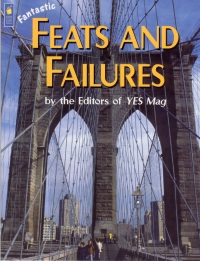| ________________
CM . . .
. Volume XI Number 2 . . . . September 17, 2004
excerpt:
The World Trade Center, Sydney Opera House, Brooklyn Bridge, Chernobyl, Canadarm. What makes successful structures and technologies so awe-inspiring is that it was mere mortals who figured out how to put them together. What makes the failures so horrifying is that from these same mortals we demand unattainable infallibility. This wonderful book captures both the awe and the horror, as well as the hope that lessons learned from mistakes move us closer to more safe and reliable engineering marvels. Fantastic Fears and Failures is written by three editors of YES Mag, an award winning, bimonthly science magazine dedicated to introducing kids to science, technology and engineering in fun and educational ways. David Garrison, Shannon Hunt and Jude Isabella started YES Mag from their home in Victoria, BC, and have racked up awards including the Eve Savory Award for Science Communication, the Michael Smith Award for Science Promotion, a number of periodical publishing honours and a place on the Canadian Children's Book Centre "Our Choice" list for six years running. (Their website is also wonderful and includes science book reviews from young readers). Teamed up with Kids Can, this book offers rich content and great design. The writing is clear and simple for even the least engineer-savvy reader, with a good balance of technical information with effective comparisons, historical context, and people stories conveying the drama behind these engineering wonders. Older readers will appreciate the attention paid to the ethical issues involved in engineering, including the responsibility of the engineer of record, sacrifices made by workers building ambitious structures (caisson disease), and, to a lesser degree, the inequity that exists in North American and international safety standards (Chernobyl and Bhopal). More attention could be paid to the inequalities that exist between rich and poor in living with risks like those covered in the book, taking the willing reader deeper into the subject. Basic engineering concepts including compression, tension, translational and rotational force are covered with admirable clarity, and several hands-on activities are offered to "drive" the concepts home. Most of the structures or technologies covered (20 in total) are presented in one or two pages, with photos and effective illustrations to reinforce concepts, as well as information set apart from the text for skimming. A clean, airy design makes reading feel less onerous, but great photos and generous white space are not trade-offs for good writing and well chosen content. A glossary and index are included. This book, as well as YES Mag's book on the International Space Station, would be wonderful assets to any library or classroom's science offerings. It would be particularly popular with readers who are looking for information books packed with lots of interesting facts to share and content presented in small doses. This is also a book that offers adults information that they'll wish was as effectively communicated in the media where engineering feats and failures are regularly covered. The broad appeal of this book makes it a great recreational read, as well as a book to enjoy together. Highly Recommended. Lori Walker, who is writing middle school nonfiction based on her doctoral work on risk communication at Simon Fraser University, is completing a Masters in Children's Literature at UBC.
To comment
on this title or this review, send mail to cm@umanitoba.ca.
Copyright © the Manitoba Library Association. Reproduction for personal
use is permitted only if this copyright notice is maintained. Any
other reproduction is prohibited without permission.
NEXT REVIEW |TABLE OF CONTENTS FOR THIS ISSUE
- September 17, 2004.
AUTHORS
| TITLES | MEDIA REVIEWS
| PROFILES
| BACK ISSUES
| SEARCH | CMARCHIVE
| HOME |
